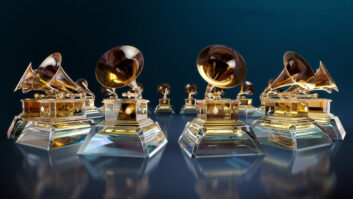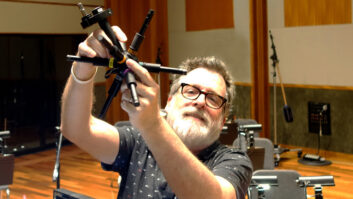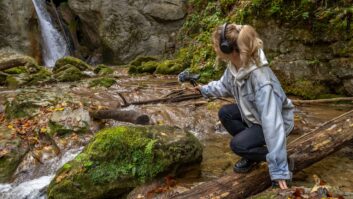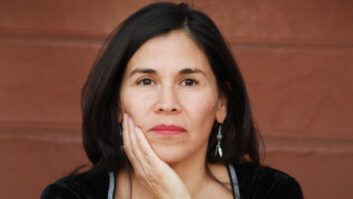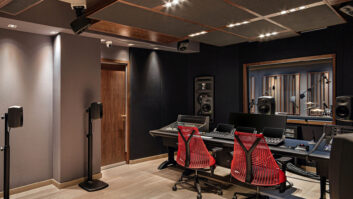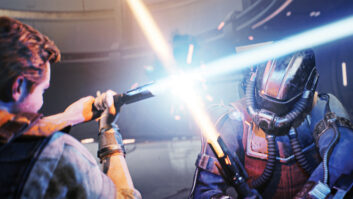A John Rodd session: musicians performing the score for an animated short film at Capitol
The conceit of these sorts of periodic articles, which are designed to fill readers in on the latest recording techniques, is that there is great new information to be imparted — that changes in technology have led to some sort of reassessment of the way a particular musical style is captured for posterity. But the fact is, in the world of orchestral recording, there doesn’t seem to be radical departures in the way that engineers are working, even as the ultimate media destinations have almost entirely moved from tape to digital disk storage. Traditions run deep in classical music recording, and while it isn’t exactly accurate to say that there’s nothing new under the sun, there is still a great reliance on tried-and-true methods that have been successful for many decades, though it isn’t hard to find a few new wrinkles, too.
With that in mind, we contacted four engineers steeped in the wisdom of how to best record an orchestra, whether for a classical production, a film score or as background on a pop date. Lawrence Rock (you can call him Larry; many do) has been the audio director of the New York Philharmonic for nearly a decade, and has made countless classical recordings both in recording studios and, more often, live in concert. Long revered as an intelligent and resourceful studio owner (Ocean Way, Record One, et al), Allen Sides’ greatest passion has always been engineering, and he’s recorded orchestras for many pop and rock records (Goo Goo Dolls, Sheryl Crow) and film scores. These days, John Kurlander mostly engineers film scores in L.A. (The Lord of the Rings films, Master and Commander, etc.), but during his more than three-decade career, he has also cut dozens of straight classical albums and has worked with orchestras on numerous rock LPs. John Rodd, the youngster of the group, cut his orchestral recording chops in the late ’80s and early ’90s in his native Canada, working on classical and film scoring dates at Manta Sound in Toronto and the Banff Center for the Arts (Alberta). Later, he moved to Los Angeles and landed a job as a scoring recordist at Fox’s Newman Scoring Stage and is now an independent engineer specializing in recording orchestral film and videogame scores.
MODIFIED OLD SCHOOL
For a half-century, orchestral recording has been dominated by two techniques that emphasize minimal miking in front of and above the musicians: The Blumlein method, developed in the early 1930s, uses a single pair of bidirectional mics to create an accurate stereo image; and the more popular Decca Tree, developed by engineers for Decca Records in the mid-’50s, uses three microphones on a T-stand (the classic iteration used Neumann M-50s) to give optimal left, right and center imaging for recording. (For a detailed, cogent look at the Decca Tree, see Ron Streicher’s September 2003 Mix article at mixonline.com.)
There are still some purists who fully embrace these proven “old-school” techniques, but it has been much more common during the multitrack age for engineers to augment either the Blumlein or Decca setup (often modifying each) with spot mics over small groups of players or sections of the orchestra that can be brought into the mix later. All four of these engineers favor a modified Decca Tree with spot mics. And, not surprisingly, surround recording also considerably changes the mic equation.
John Kurlander at the Neve Capricorn at CTS Studios, Watford Town Hall, UK
Kurlander got his start at EMI (Abbey Road) Studios in London in the late ’60s. After several years working his way up from “tea boy” to assistant, he got his first shot as lead engineer on a classical project in 1975. “I went up to Liverpool with instructions from one of the chief engineers who said, ‘Look, just do as you’re told and don’t experiment. I’ve been doing Liverpool Philharmonic Hall for 20 years now and this is how you do it.’ You had classical engineers and pop engineers; they were very, very separate. The EQ modules for the valve boards even said ‘pop’ or ‘classical’ on them.
“The Decca Tree was the tradition from Decca, which was about a mile down the road from us,” he continues, “and the tradition for EMI Classics was a Blumlein stereo pair, so you could get into serious trouble if you tried putting three M50s up. [Laughs] And, likewise, the Decca boys would have been in trouble if they had put up a Blumlein stereo pair. The truth is, even the guys who worked for Decca were constantly trying to second-guess [the Tree]. Even though they probably had the formula framed on the wall, they were still wondering, ‘What if we tried something else on the center? What if we went a little wider?’”
By the late ’70s, Kurlander found himself working increasingly on hybrid pop/classical projects. “You know that joke in This Is Spinal Tap where they say they want to do some of their acoustic numbers with the London Symphony Orchestra? Well, that joke was based on what actually happened! Every rock band worth its salt wanted to overdub the London Symphony.”
Kurlander says that unlike in straight classical recording, when the orchestra’s natural dynamic range is maintained, an ensemble being layered over a rock track requires different mic treatment. “I would typically mike it up from three different perspectives: a close, a medium and a distant. Then I started compressing those three layers. In those days, I would probably have six or eight mics close, then a medium [pair] over the conductor and then a really distant [pair]. A lot of times, I wouldn’t be mixing it. The engineer who had recorded the [pop] tracks would come along and I’d give them very specific guidelines on how to mix my tracks. By using the multi-perspective technique, you’d actually come out with something that was relatively squashed up but gave the illusion of being dynamic and natural.”
Today, Kurlander says, the modified Decca Tree has become a standard for film scoring. “I use the [Neumann] 150s [a modern update of the M-50] simply because they’re new and they’re matched and they’re reliable, and reliable is really important. So I’ll do that and then do a round of closer mics, depending on what the score is, because you never really know what you’re going to need [in the mix].
“I’ll put my initial Tree at 10 to 12 feet. Then I’ll have a circuit of close mics in the sections, and that would depend on the size and the writing and where we’re recording — how close they’re going to be. It could be as few as five or six mics or up to as many as 18 or 20. I use a lot of [Neumann KM] 84s or derivatives of 84s — the 184s. And if I have to go closer than about 12 to 18 inches, I prefer not to go that close with a modern condenser and I’ll use a ribbon. And if I’m going to go for violin solo or a cello solo, I’ll use a ribbon, as well. For surround, I’ll have a pair of very high omnis, and sometimes I’ll add in some of the Tree’s left and right into the rears.”
LIVE CHALLENGES
Most of what Rock records for the New York Philharmonic are live concerts for either broadcast or CD release, putting him in a different position from the other engineers. Not only does he have to deal with a live audience, he usually doesn’t have the opportunity to switch miking schemes between musical pieces at a given performance, even if there are significant changes in style or instrument configuration. And if he’s working a broadcast, he also has to consider the dynamic limitations of radio compression.
Lawrence Rock in the radio room at Avery Fisher Hall, home of the New York Philharmonic
Photo: Chris Lee
“When you’re recording live, you’re dealing with an audience and the noise they make, and any concert hall is going to become less reverberant when people are in it. As a result, I have to use digital reverb; in fact, I’ve often said that I’ve built my career on the judicious use of digital reverb,” he says with a chuckle.
Rock says he has mostly used Lexicon reverbs during the years. “The 300 has been my workhorse because the digital interface is so straightforward. Of course, I go back to the era of the 200 and the 224, which didn’t even have digital interfaces.”
When asked about the newer generation of reverbs that actually emulate some of the classical halls in which he records, he says he doesn’t like the “known room” approach, “because in my mind, what you’re really creating is an idealized version; what we’re creating is an illusion. Microphones don’t hear the way ears do — you don’t have the brain to sort it all out until you’re listening on the other end, and then you’re listening to speakers or headphones. So you’re really creating a whole sound that’s certainly related to the source, but it’s hardly an exact replication. So you use whatever you have at your disposal in terms of types of microphones and the placement and whatever processing you need. That said, in the classical world, we try to minimize processing — choosing the microphone that has the kind of sound you’re going for and then not adding equaliztion to it because, be it analog or digital, you’re still introducing a form of distortion, technically speaking.”
Rock says that growing up in Chicago, he was well aware of the Decca Tree approach. “During the [music director Sir Georg] Solti era, they always had the Decca Tree and they applied that approach no matter what hall they were recording in, and I think the results were variable. Sometimes they would have seven of the modified M-50s — a Tree and two outriggers on each side — and it was too much of the same mic sound; it got a little muddy and a little brittle.”
Rock likes to mix mics, avoiding the buildup of the coloration of any given mic. “What I generally use is a combination of the Neumann KM-130s, which are the omnis — in fact, I use them with the little [sound defraction] spheres that make them, as I call them, the poor man’s M-50 — in the center, and then I use the Schoeps MK2S, which is an omni capsule that has a little bit of high-end rise, as does the Neumann 130. In a place like Avery Fisher Hall here [in N.Y.], and really, working in any hall with an audience present, the first thing to go is the high-frequency return — the kind of reflections and so on that would support high frequency. So those mics are both good for that.”
How far up does he hang the mics? “Just under 10 feet; nine-feet-11 to be exact,” he says with a laugh. “You get this sweet spot. These four mics hang in a line in front of the orchestra, spread horizontally. The center ones are 18 inches apart; the outriggers are another 12 feet out on either side. One of the things that does is give me flexibility in changing the balance between the inner pair and outer pair. The Schoeps tend to be a little warmer-sounding and the Neumanns are a little more brilliant and have a little more reach. A program might have a wide variety of pieces, and I can’t go down there and change mics and change positions in the middle of a concert. But I can change the balance, and if I need a warmer sound, I can bring the Schoeps up, and if I need a clearer sound, I can bring the Neumanns up.” When it comes to spots, “I’ll use some of the KM-140 cardioids over woodwinds and some string spots. I also like the MK21, which is the sub-cardioid Schoeps. Generally, I go from the omni to the more directional as I go upstage.”
CAPTURING SMALLER ENSEMBLES
A conversation with Sides centered on his involvement with the most recent Crow album, Wildflower, which features sumptuous orchestral accompaniment (by veteran pop arranger David Campbell) on nearly every song. While Sides certainly has experience working with larger orchestras, for this pop date, he recorded a smaller ensemble. The sessions took place at Ocean Way B in Los Angeles.
“The way I record [strings for a pop album] is not that different than what I do for a motion picture,” Sides says. “The big live rooms we have sound so good that with the right section and the right setup and a pair of M-50s and the right spot mics, it sounds pretty amazing without having to work all that hard. It’s one of those things where simplicity is really the way to go.
Allen Sides leaning over Capitol’s custom API board, with (from left) assistant engineer Scott Barefield, Burt Bacharach (foreground) and music director Rob Shrock
“With the smaller sections,” he continues, “I set it up a little differently than with a larger orchestra. Typically, with David [Campbell], it will be like 12 violins, three cellos and three violas, so I end up making three rows of six: six violins, six violins and then the three violas and three celli in the last row.
“One of the challenges of recording a section like that is if you have your overall mics aimed at the first row of players, it ends up sounding like a few violins playing. With M-50s, which are actually fairly directional mics above 1k, if you aim past the front of the section, you end up getting a more unified sound. If what you’re looking for is a more impressionistic sound, where you don’t actually hear any one individual string but you really hear it as a group, I’ll aim the M-50s more toward the last row. Then, what I’ll usually do in a small section like that, I’ll have three KM-54s for the L/C/R violins. If it’s going to be 5.1, I’ll put up a center M-50, plus I’ll put up a couple of Schoeps omnis, sometimes left-right distant front, also left-right rear, depending on what perspective I want with the 5.1.”
With the front M-50s, “Depending on the room, I’m usually about 12 feet in the air and sometimes as much as 15 feet — depending on the size of the section,” Sides continues. “The bigger section I might split up in a more conventional fashion — say, four, four, four and four violins on the left; then four and two celli and four and two violas on the right; and the bass is in the center in the back. The other thing I do a lot of is if we’re recording two basses, I usually record them in stereo with a couple of [Neumann] U47s because it sounds impressive in pop and they’re also centered in the section, so if I have it six, six and six [as in the Crow date], the two basses are dead center in basically a fourth row, so they’re also being picked up evenly by the M-50s.”
For spot mics, “I’ll put a couple of 54s or omni 67s on the violas, and then I use a couple of 54s on the celli. The reason I use a 54 is because they have an incredibly smooth off-axis response. Usually, I’d put one per two celli; if it were four, I’d have two; if it were three, I’d have a left and right and have the mics a little farther apart and a little closer to the outside, because if they combine to mono, the center guy will be too loud.”
When it comes time to mix, Sides says, “If it’s a wide-open track with lots of space, I’ll probably use much more of the overalls. Usually, I’ll add a little viola, a little celli and not necessarily any of the close violin mics. But if it’s a very dense track with multiple doubled guitar parts and lots going on, I’ll probably need a little more of the close mics to fill in the distance. It always depends on what the track needs.”
ROOM, ROOM, ROOM
Rodd, whose recent credits include DreamWorks’ The Madagascar Penguins in a Christmas Caper, has also seen a lot of variations on the Decca Tree in the film scoring world. “Sometimes, you might see five microphones across the front, as well as spot mics. Every engineer has his own favorite way of doing it,” he says. “In a good-sounding room, I’d say the room is probably going to be about 80 percent of the sound and the spot mics are more for presence than volume. On the Newman stage, for instance, depending on the score, the woodwinds often speak so clearly that you need minimal spot-miking. They’re there for some presence and articulation.” Rodd’s favorite main mics are the Sennheiser MKH 800s, “and I’ve also been pleased with the Neumann 149s.
“Awhile back,” Rodd relates, “I was recording a feature film score in a room that was more live than I would have liked, and the string section was proportionally a little bit small for the brass section. The players were all in one room, so I had to drop the spot mics a little bit closer than I might ordinarily, especially on the strings. I was aware of this going into it, so I was careful in terms of using the rejection side of the spot microphones in my favor and using a little bit of baffling, but still trying to use as few mics as possible. I guess I approached that session more like a TV date. In TV, you don’t rely on room mics as much. With a smaller ensemble, in terms of speed and flexibility, it’s more about putting all the sections together and making sure that you can move quickly and balance things and not be reliant on the room sounding balanced.
“There are so many variables to consider before you start recording. Is there a huge dynamic range [in the music]? Are there featured soloists? Is there any musical element that’s more important than anything else? Is it a lush pastoral score or more aggressive and edgy? Sometimes you have to pick which mics and mic placements are going to work for what the composer likes: Do they like an aggressive sound or a more lush sound overall?”
For an animated project called Smile, with music by Cody Westheimer, Rodd found himself recording a 45-piece orchestra at Capitol Studios A and B. “I put the strings and woodwinds in Studio A and then I put in the glass wall that divides A and B, and had the French horns, trumpets, trombones and tuba in Studio B. I put the conductor with his back to the glass wall that divided the two rooms,” he says. “Depending on the writing of the music, the brass and so forth can overcome the smaller string section if they’re all in one room. So the way I set it up, as it was a loud score, the brass could play as loud as they wanted and I could still have a refined string sound because the spot mics could be a little farther away from the instruments. It also really helped with editing because we could edit the brass differently than the strings as we had total isolation. Don’t get me wrong — I’m a big proponent of having everyone in the same room at the same time, but with that particular size of an orchestra, that’s a good way to work if you are at a studio like Capitol.”
Blair Jackson is Mix’s senior editor.
